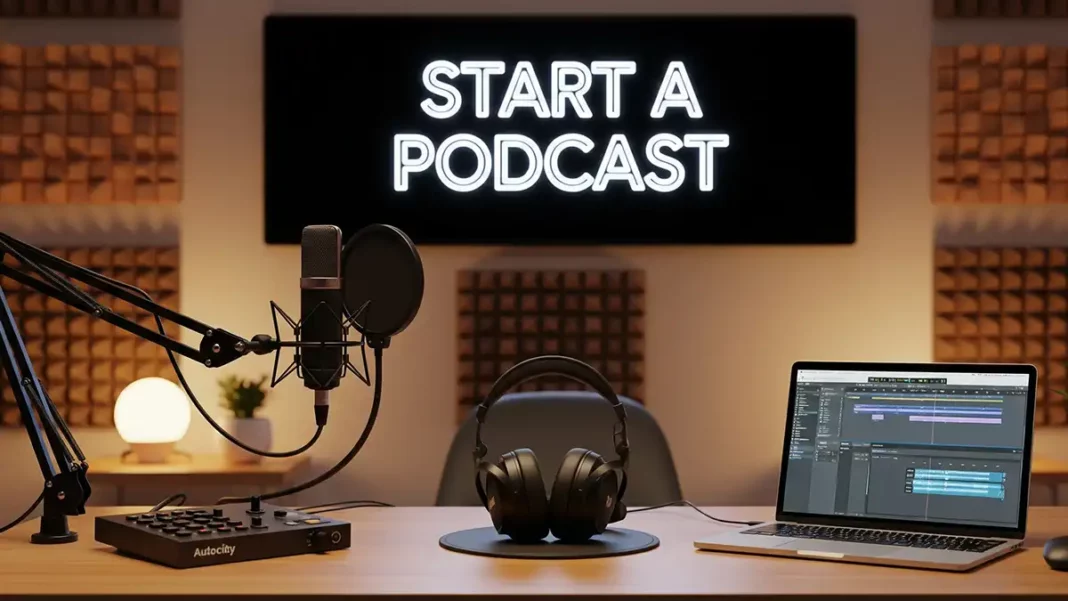To Start a Podcast, can feel like stepping into a vast, uncharted ocean, fraught with technical jargon, equipment choices and the looming question of how to even get heard. Are you ready to transform your voice, your ideas and your passion into captivating audio content that resonates with listeners worldwide?
In this comprehensive article, you will gain a clear roadmap on how to Start a Podcast from scratch, covering everything from conceptualization and equipment to recording, editing, hosting and promoting your show, ultimately empowering you to build a thriving auditory community.
Laying the Foundation: Concept and Planning
Before you even think about microphones or editing software, the most crucial step to Start a Podcast effectively is meticulous planning. A solid concept acts as your North Star, guiding all subsequent decisions and ensuring your podcast has a clear identity and purpose. Without this, even the best technical setup can lead to an aimless show.
Defining Your Niche and Audience
The podcasting landscape is incredibly vast, with millions of shows competing for attention. To truly Start a Podcast that stands out, you must identify your unique niche.
What specific topic are you passionate about? Who is your ideal listener? Is it “urban gardening for busy city dwellers,” “deep dives into forgotten historical events,” or “the psychology behind video game addiction”? The more specific your niche, the easier it will be to attract a dedicated audience.
Understand their demographics, interests and what problems your podcast can solve or entertain them with. This clarity will inform your content, tone and even your marketing strategies, ensuring your message reaches the right ears.
Crafting Your Podcast’s Identity
Once your niche is clear, it’s time to craft your podcast’s identity. This involves more than just a name; it encompasses your show’s tone, format and overarching message.
Will it be an interview show, a solo monologue, a narrative storytelling format, or a conversational co-hosted discussion?
Consider the ideal length of your episodes and how frequently you plan to release new content. Brainstorm catchy, memorable names that reflect your topic and are easy to pronounce and spell. Develop a distinct voice and personality for your show.
This identity is crucial for building a strong brand that listeners can connect with and easily recognize across various platforms, making it easier for people to discover and follow your podcast.
Equipping Your Studio: Essential Gear to Start a Podcast
You don’t need a professional recording studio to Start a Podcast, but investing in some fundamental equipment is crucial for producing high-quality audio. Good sound quality is non-negotiable; it keeps listeners engaged and makes your show sound professional. Don’t let the technical aspects intimidate you; a basic setup can yield excellent results.
The Microphone: Your Voice’s Best Friend
The microphone is arguably the most important piece of equipment for any aspiring podcaster. It directly impacts the clarity and richness of your voice. For beginners, a USB microphone is an excellent starting point, as it plugs directly into your computer and is relatively simple to set up. Popular choices include the Blue Yeti, Rode NT-USB Mini, or Shure MV7 (which offers both USB and XLR connectivity).
For those looking to upgrade or record multiple speakers, an XLR microphone paired with an audio interface (like the Focusrite Scarlett 2i2 or Behringer UMC202HD) offers superior sound quality and more flexibility. Remember to use a pop filter to reduce harsh “p” and “b” sounds, making your audio sound smoother and more professional.
Headphones and Recording Environment
While often overlooked, quality headphones are essential for monitoring your audio as you record, allowing you to catch any issues like background noise or microphone placement problems in real-time.
Closed-back headphones are recommended to prevent sound bleed from your headphones into the microphone. Equally important is your recording environment. Choose a quiet space with minimal echoes.
Soft furnishings, curtains and even blankets can help absorb sound and reduce reverberation, making your voice sound clearer and more intimate.
Avoiding hard, reflective surfaces will dramatically improve your overall sound quality, ensuring your efforts to Start a Podcast are heard in the best possible light.
Recording and Editing: Bringing Your Podcast to Life
Once your concept is solid and your equipment is set up, the real fun begins: recording your first episodes. However, the raw audio is just the beginning. Editing is where your podcast truly takes shape, transforming raw recordings into polished, engaging content ready for your audience. This crucial stage defines the listening experience.
Recording Software and Techniques
Choosing the right recording software (often called a Digital Audio Workstation or DAW) is pivotal. For beginners, free options like Audacity (cross-platform) or GarageBand (macOS) are excellent starting points.
For more advanced users, Adobe Audition, Reaper, or even specialized podcasting platforms like Riverside.fm (which offers remote recording) provide greater control and features. When recording, speak clearly and at a consistent volume. Practice good microphone technique, maintaining a consistent distance from the mic.
If recording interviews, consider “double-ender” recordings where each participant records their own audio locally, leading to superior sound quality compared to relying solely on online call quality. This attention to detail will help you start a Podcast with exceptional audio.
Hosting and Distribution: Start a Podcast for the World
Recording and editing are vital, but for your podcast to reach its audience, it needs a home. A podcast hosting platform stores your audio files and generates the RSS feed that directories use to find and list your show. This is the bridge between your hard work and your listeners.
Choosing a Podcast Hosting Platform to Start a Podcast
Selecting the right podcast hosting platform is a crucial decision when you Start a Podcast. These services store your audio files, generate your RSS feed and provide analytics on your listeners.
Popular and reliable hosting providers include Buzzsprout, Libsyn, Podbean, Transistor and Anchor (now Spotify for Podcasters, which is free). When choosing, consider factors like storage limits, bandwidth, analytics reporting, ease of use, customer support and pricing. Many offer tiered plans, so you can start with a free or low-cost option and scale up as your audience grows. A good host simplifies the technical backend, allowing you to focus on content creation.
Promotion and Growth: Attracting and Retaining Listeners
Even the best podcast won’t find an audience by itself. Effective promotion is vital for growth, ensuring your voice reaches beyond your immediate circle and connects with a wider audience. This is where strategic outreach and leveraging podcast trends come into play.
Leveraging Social Media and Cross-Promotion
Social media is a powerful tool for promoting your podcast. Create dedicated accounts on platforms where your target audience spends their time (e.g., Instagram for visuals, TikTok for short-form clips,
Twitter for news and updates). Share audiograms (short video clips with waveform animations) of compelling moments from your episodes. Engage with your audience, ask questions and build a community around your show.
Collaborate with other podcasters in your niche for cross-promotion, appearing as guests on each other’s shows or doing shout-outs. This not only expands your reach but also introduces your podcast trends to new, relevant audiences.
Monetization and Smart Podcasting Tools: Sustaining Your Show
Once you’ve established a consistent listener base, you might consider monetizing your podcast to cover costs or even turn it into a full-time endeavor. The industry is constantly evolving, with new podcast trends and smart podcasting tools emerging to help creators thrive.
Diverse Monetization Avenues
There are several ways to monetize a podcast. The most common is through sponsorships and advertisements, where brands pay to have their products or services promoted on your show.
This can be directly negotiated or managed through podcast ad networks. Listener support, via platforms like Patreon or direct donations, allows your most loyal fans to contribute financially in exchange for exclusive content or perks.
Selling your own products or services (merchandise, courses, coaching) is another effective strategy. Some podcasters also offer premium, ad-free content or bonus episodes through subscription models. Diversifying your income streams can provide stability and allow you to continue creating the content you love.
Start a Podcast with Smart Podcasting Tools (AI-Powered)
Smart podcasting tools, particularly those powered by AI, are revolutionizing the workflow for podcasters. These tools can automate tedious tasks, freeing up more time for content creation.
- Descript: Offers AI-powered text-based editing, automatically removing filler words, transcribing audio and even re-creating your voice for corrections.
- Adobe Podcast (Project Shasta): Provides AI-powered audio enhancement, background noise removal and transcription, making your audio sound professional with minimal effort.
- Auphonic: An AI sound engineer that automatically levels audio, removes noise and masters your episodes to broadcast standards.
- Podium: An AI tool for generating show notes, summaries, chapters and even social media posts from your audio, streamlining content repurposing.
- Cleanvoice AI: Specifically designed to remove filler words (um, ah, like) and mouth clicks from your recordings.
- Riverside.fm: While primarily a recording platform, its “Magic Audio” feature uses AI to enhance audio quality.
These smart podcasting tools leverage artificial intelligence to simplify production, enhance audio quality and automate promotional tasks, making it easier than ever to produce a high-quality podcast. They represent a significant shift in how creators manage their shows, aligning with emerging podcast trends.
Conclusion: Start a Podcast
Embarking on the journey to Start a Podcast is a rewarding endeavor that allows you to share your passion, connect with like-minded individuals and build a unique community. While the process involves several steps, from conceptualization and equipping your space to recording, editing and distribution, each stage is manageable with the right guidance.
By focusing on quality audio, engaging content, strategic promotion and embracing the power of smart podcasting tools and evolving podcast trends, you can transform your voice into a compelling audio experience. The world of podcasting is waiting for your unique perspective; take the leap and Start a Podcast that truly resonates.
FAQs: Start a Podcast
What’s the most important first step to Start a Podcast?
The most important first step is clearly defining your podcast’s niche, target audience and overall concept to ensure a focused and engaging show.
Do you need expensive equipment to Start a Podcast with good quality?
No, you don’t need expensive equipment. A good USB microphone and a quiet recording space are sufficient to Start a Podcast with decent audio quality for beginners.
How often should you release new episodes to keep up with podcast trends?
Consistency is key. Weekly or bi-weekly releases are common podcast trends, but the most important thing is to stick to a schedule your audience can rely on, allowing them to anticipate your new content.
What are some examples of “smart podcasting tools”?
Smart podcasting tools include AI-powered platforms like Descript for text-based editing, Adobe Podcast for audio enhancement, Auphonic for mastering and Podium for show notes generation.
How can you promote your new podcast effectively?
Promote your podcast by leveraging social media (audiograms, engaging content), optimizing for SEO in episode titles and descriptions, submitting to all major directories and cross-promoting with other podcasters.
What are common ways to monetize a podcast after you start a Podcast?
Common monetization methods include sponsorships, listener donations (e.g., Patreon), selling your own products/services and offering premium content through subscriptions, helping you sustain your efforts to Start a Podcast.
Is it worth using artificial intelligence in podcast production?
Yes, leveraging artificial intelligence through smart podcasting tools can significantly streamline your workflow, improve audio quality and automate various tasks, making podcast production more efficient and accessible.
Also Read:
Adobe Podcast: Enhance – Studio-Quality Audio in a Click!
David William comes from an Engineering background, with a specialization in Information Technology. He has a keen interest and expertise in Web Development, Data Analytics, and Research. He trusts in the process of growth through knowledge and hard work.


